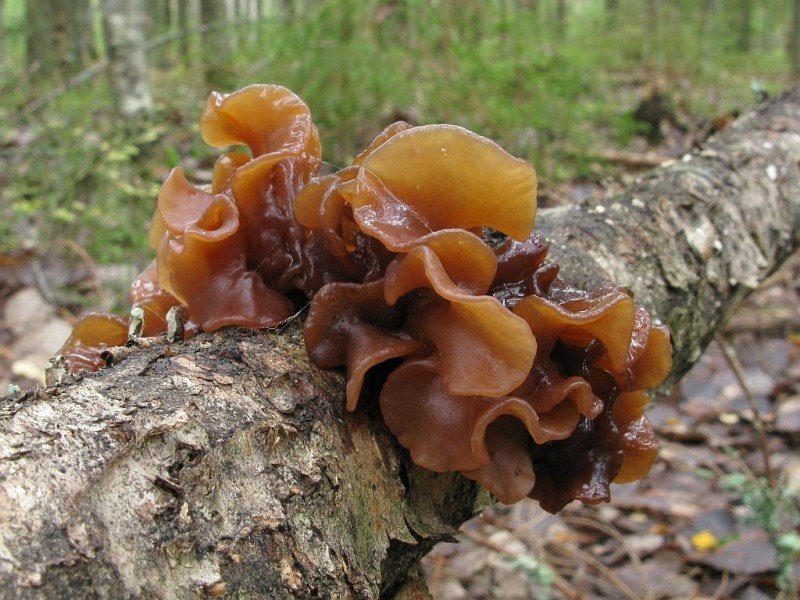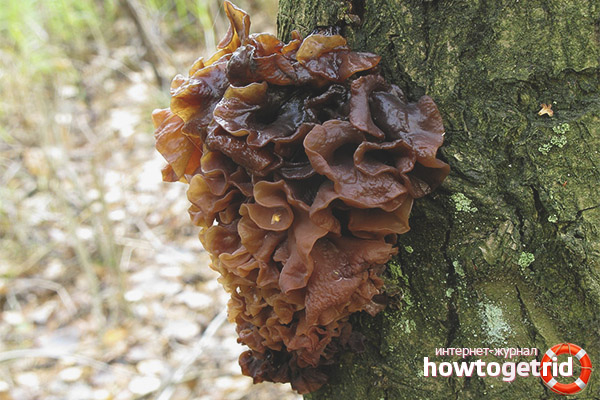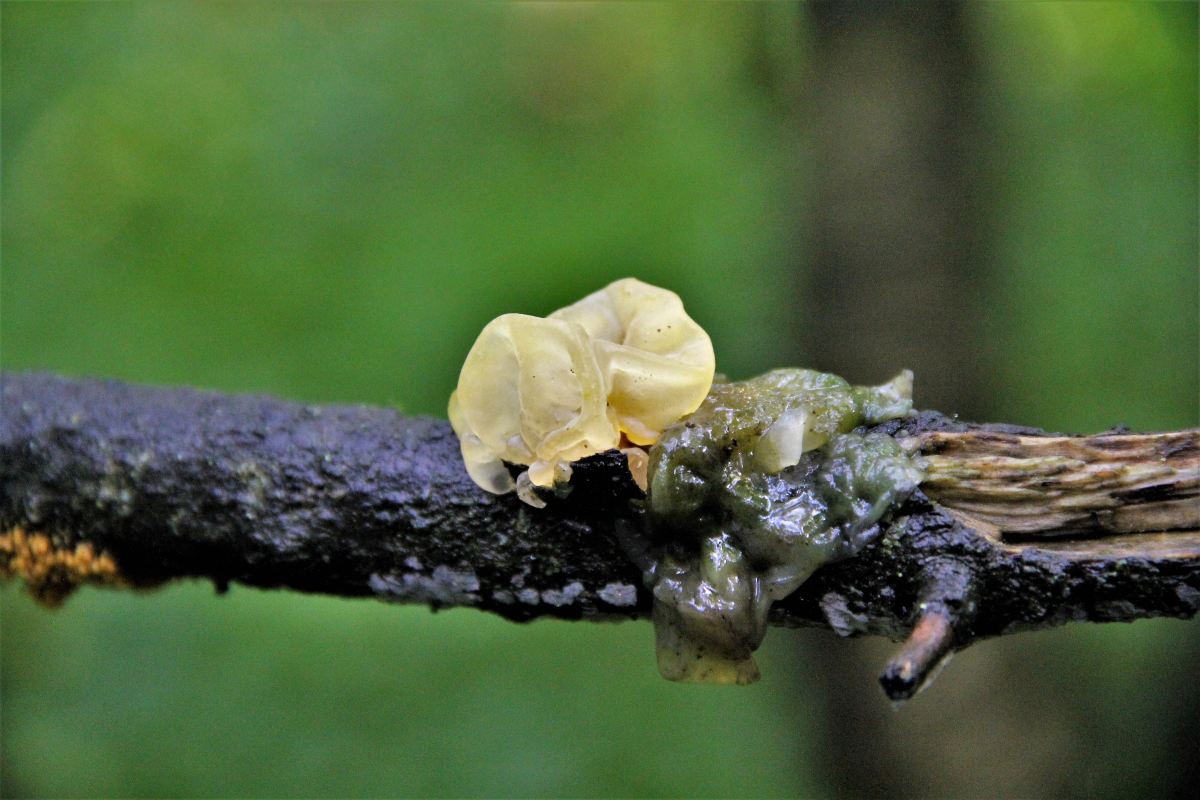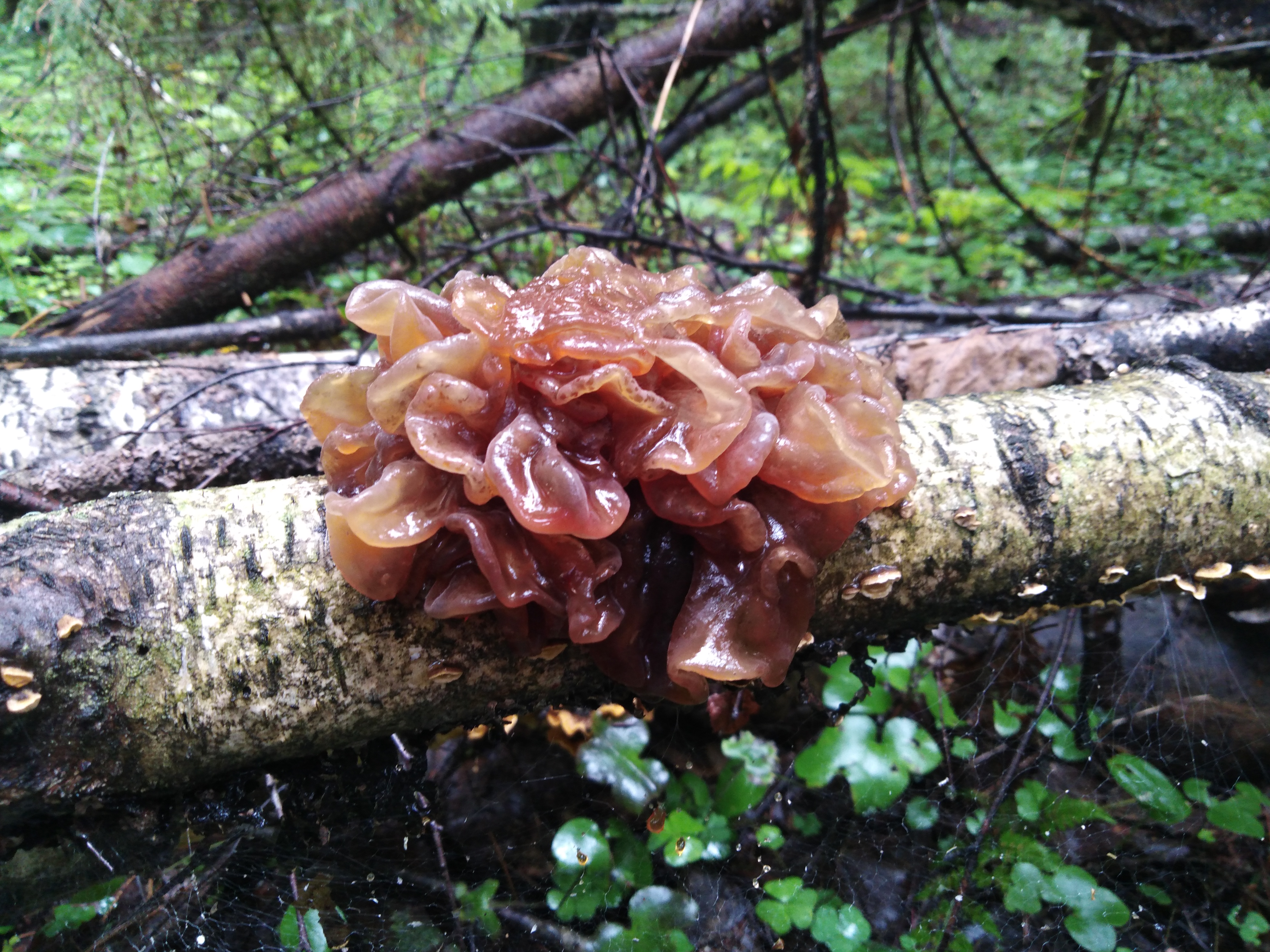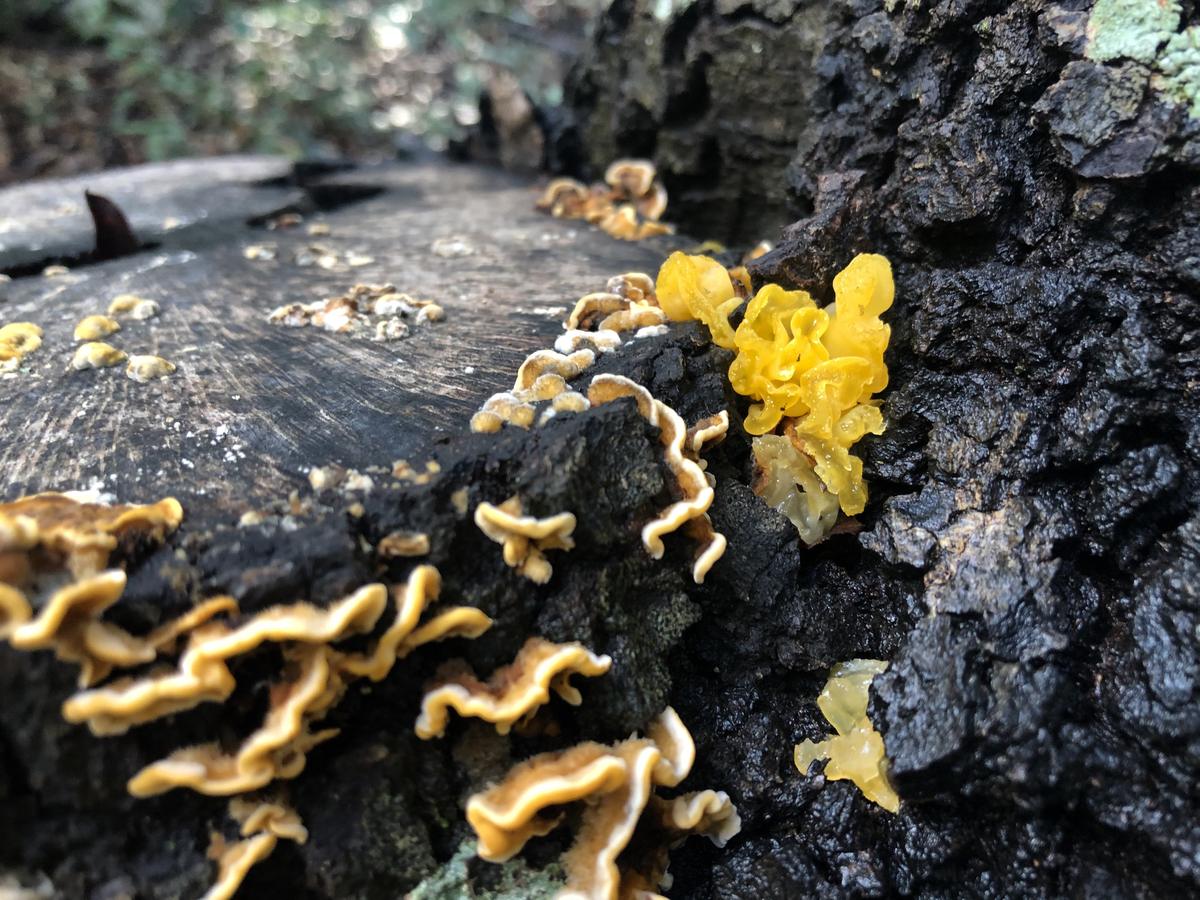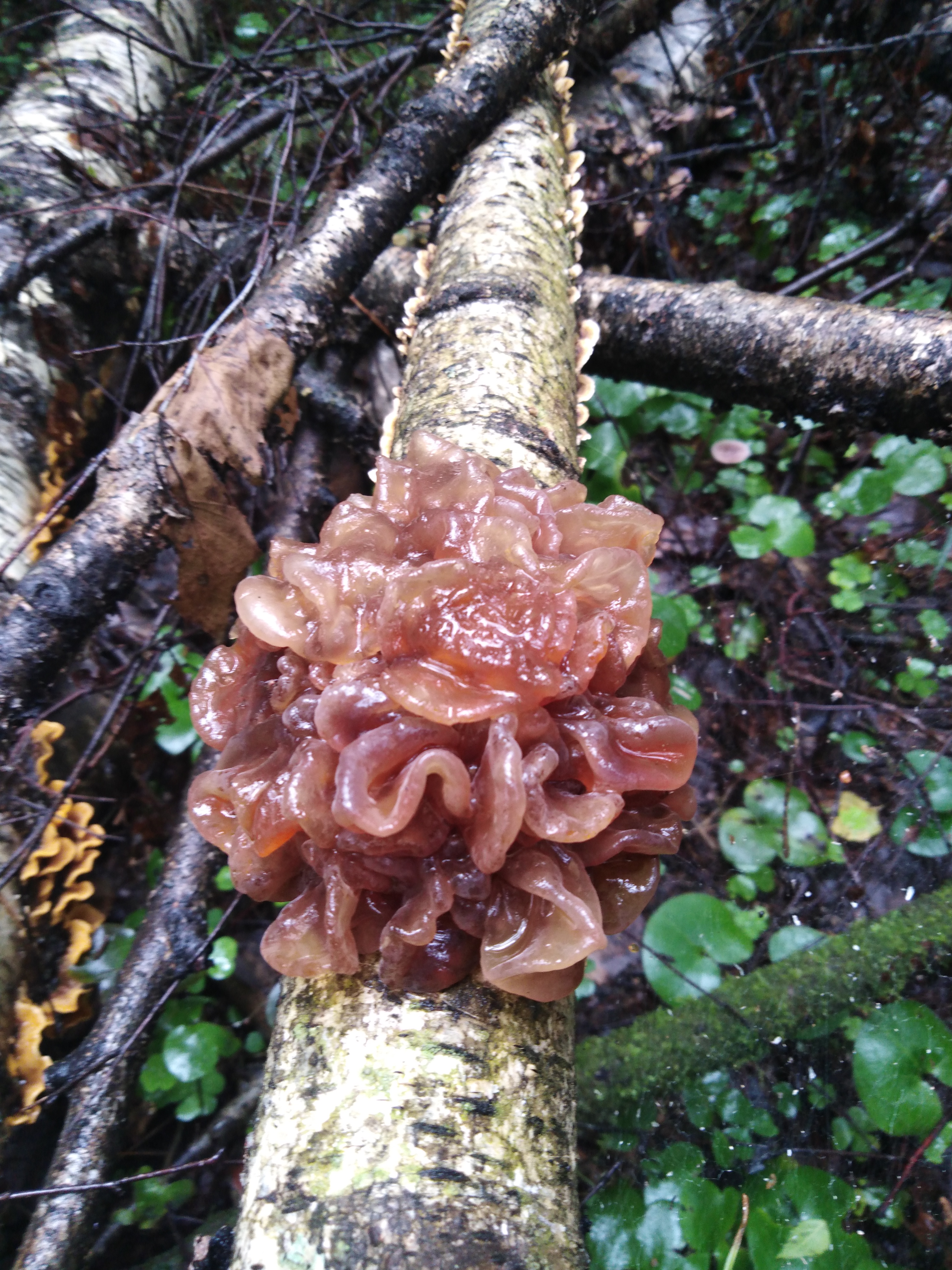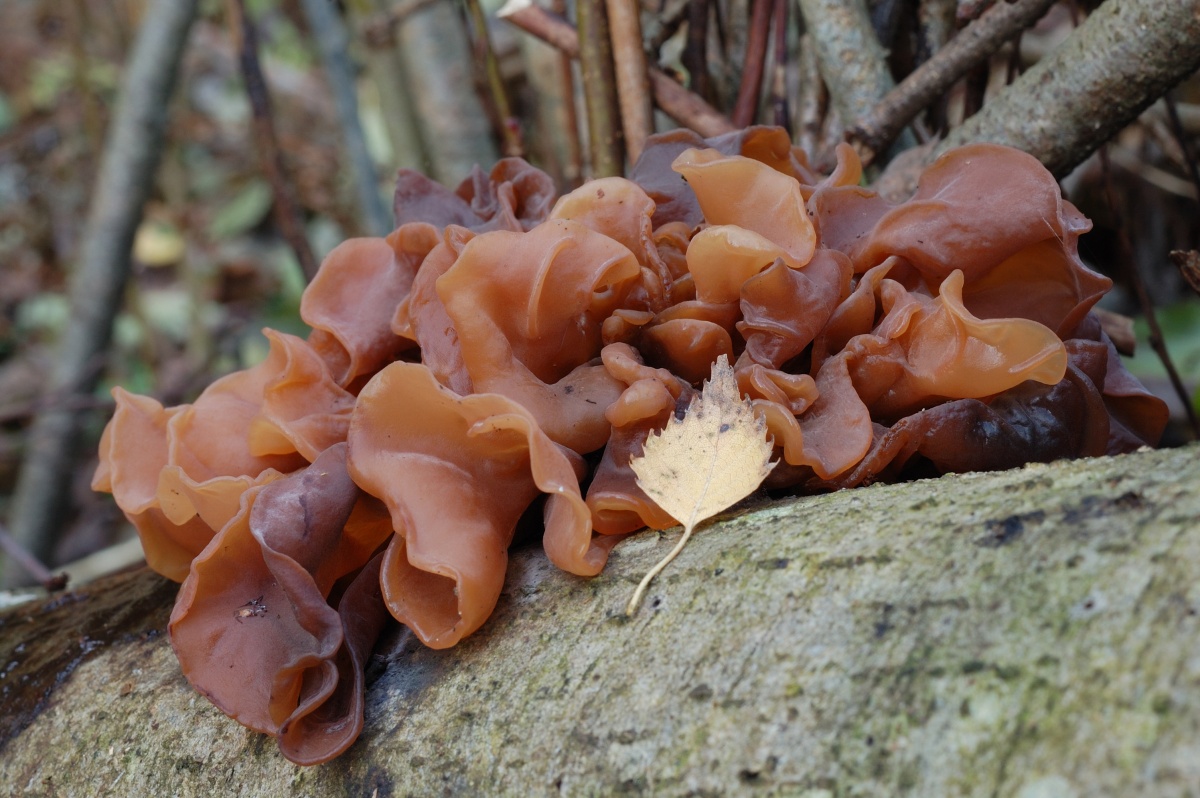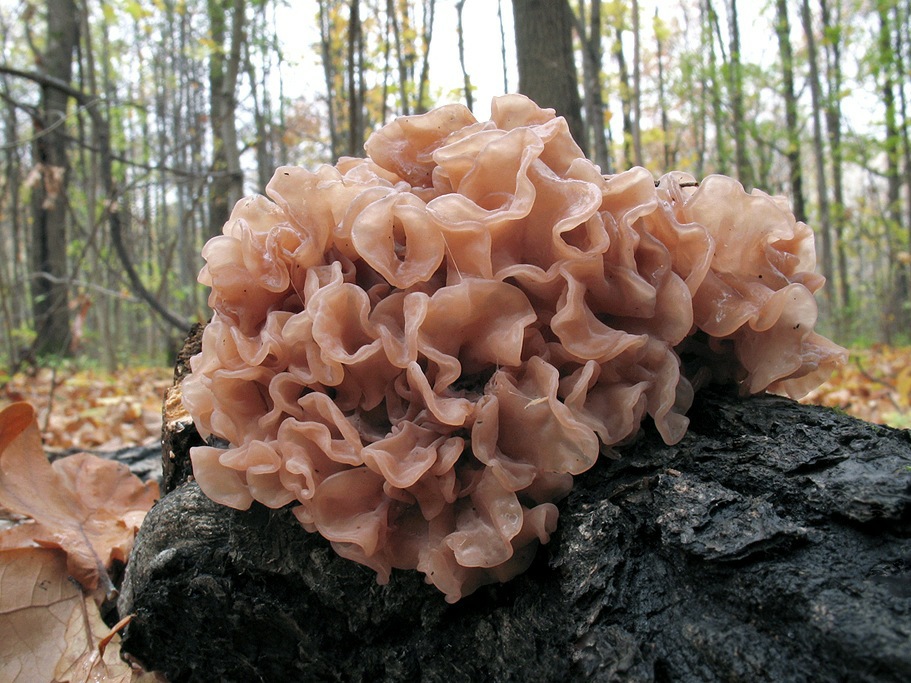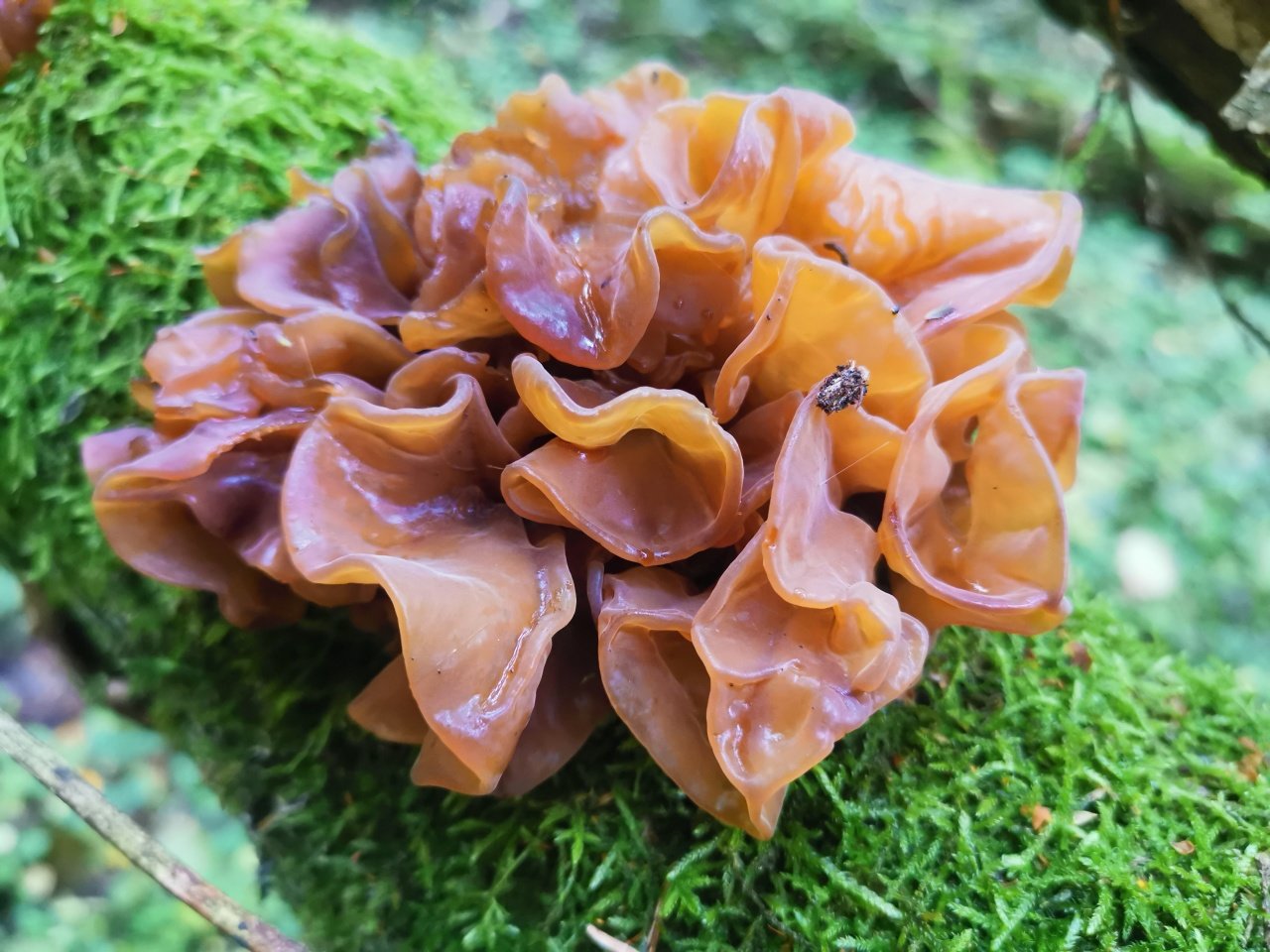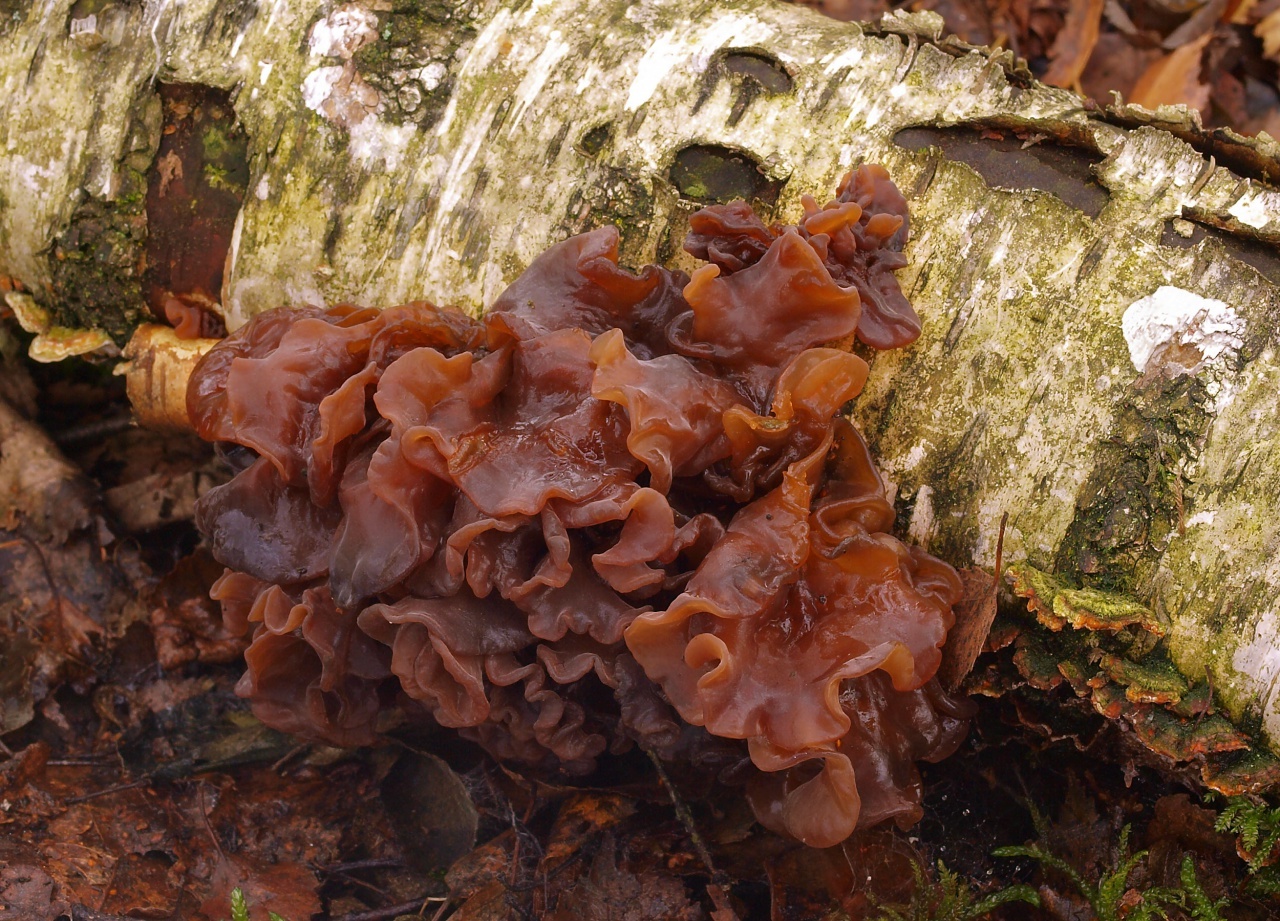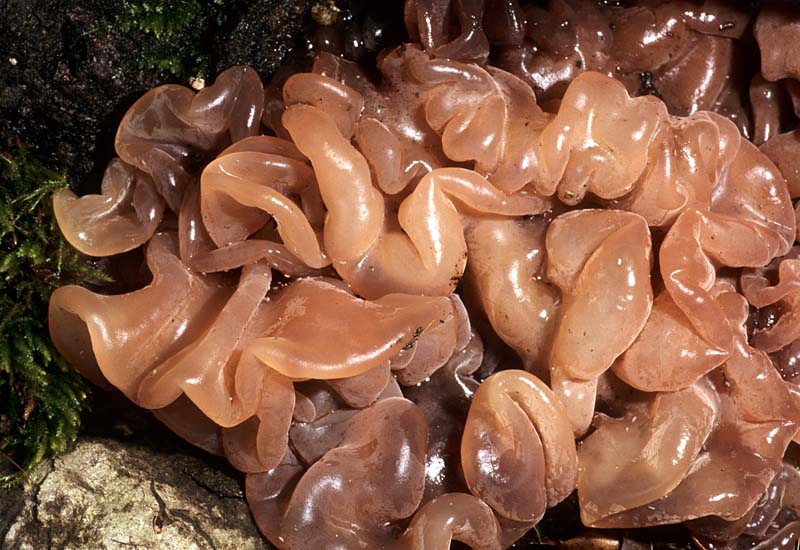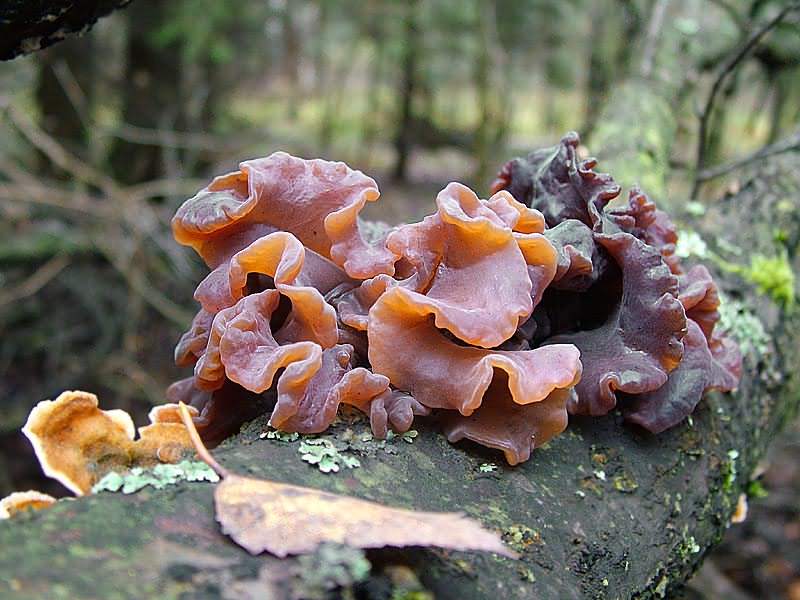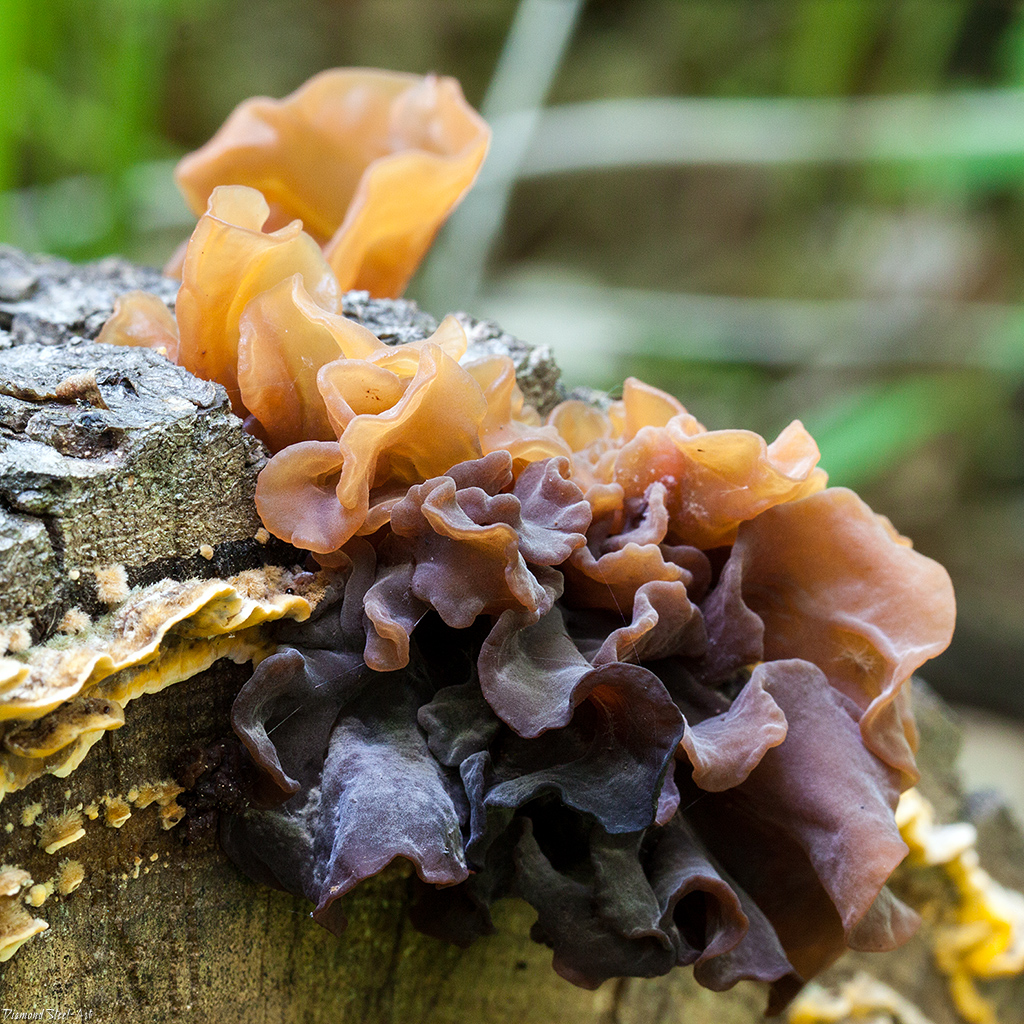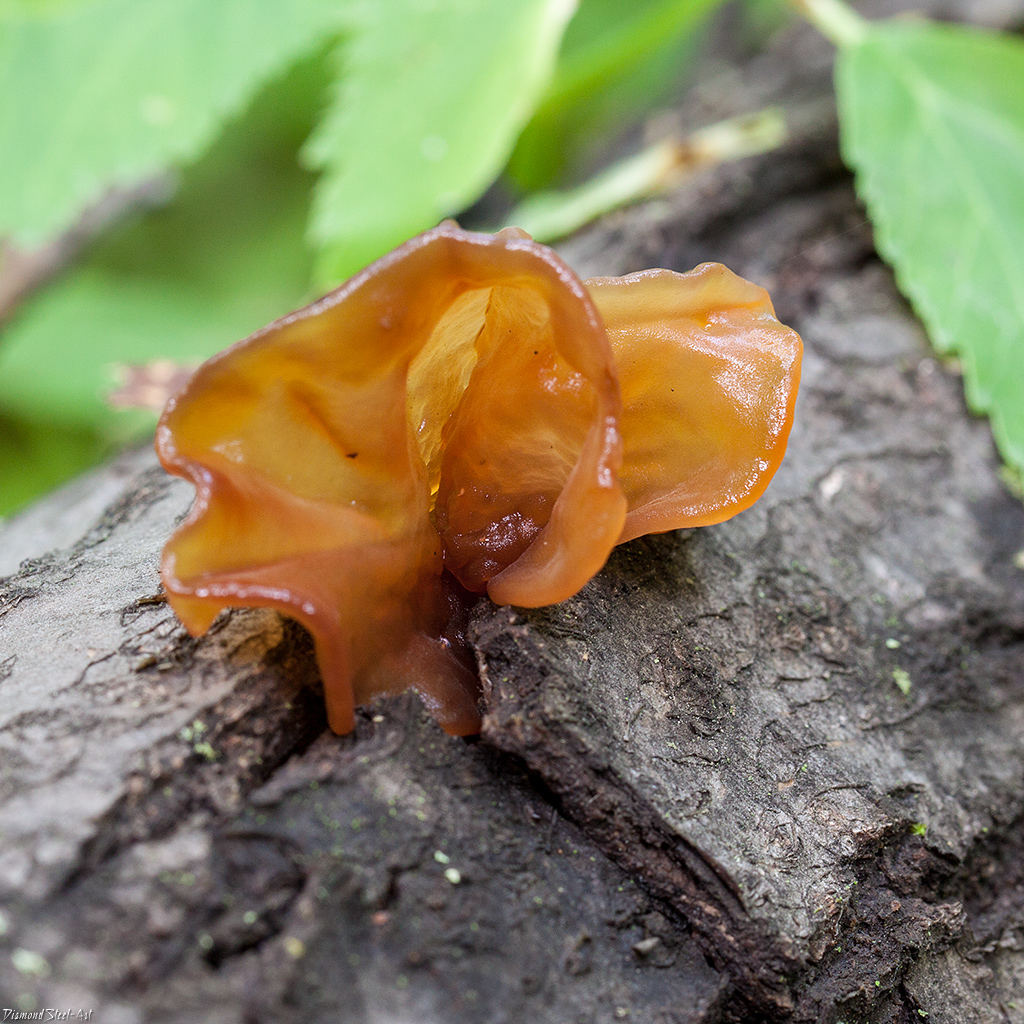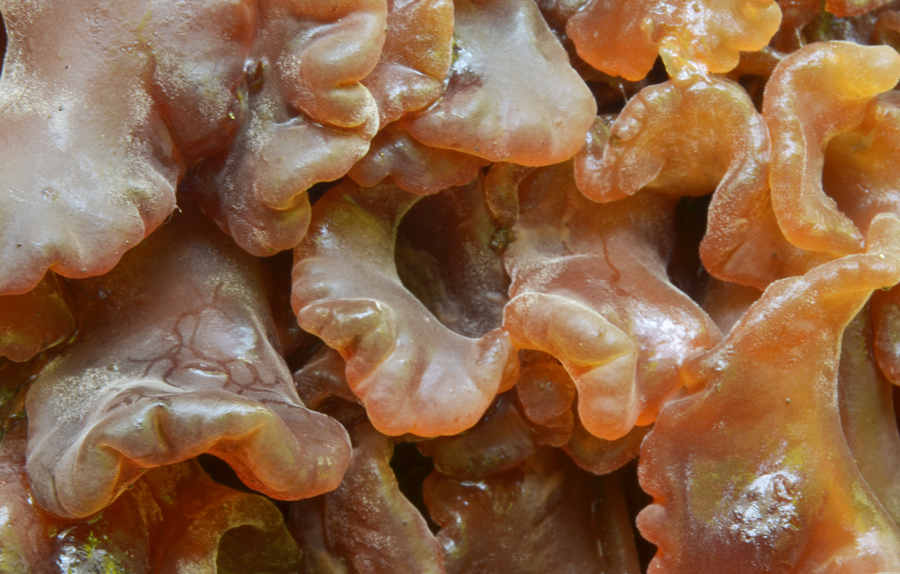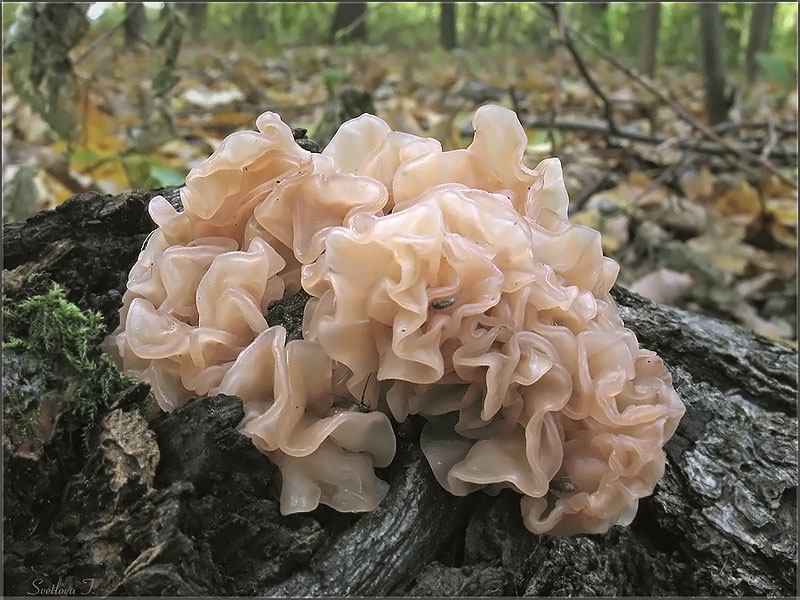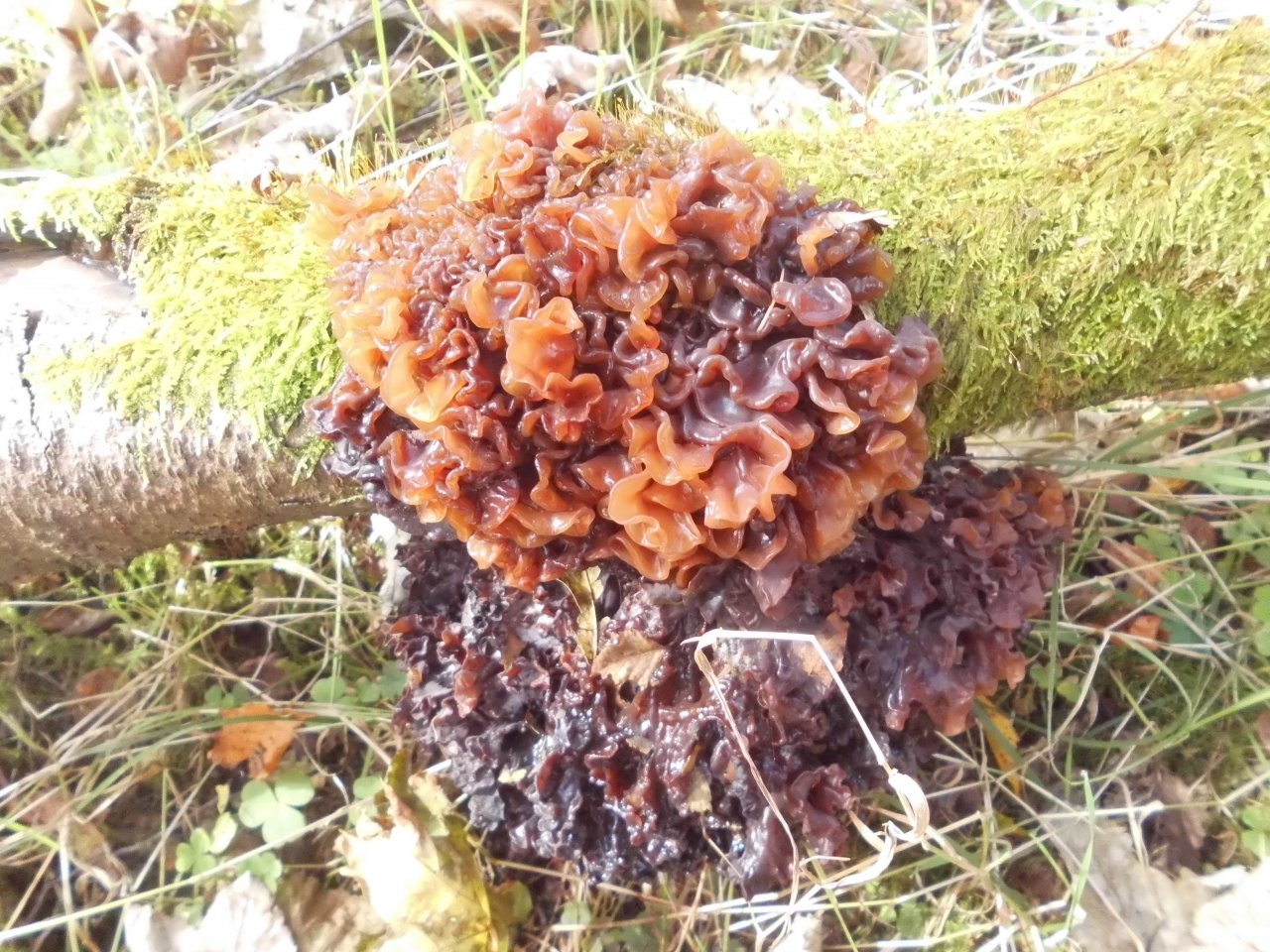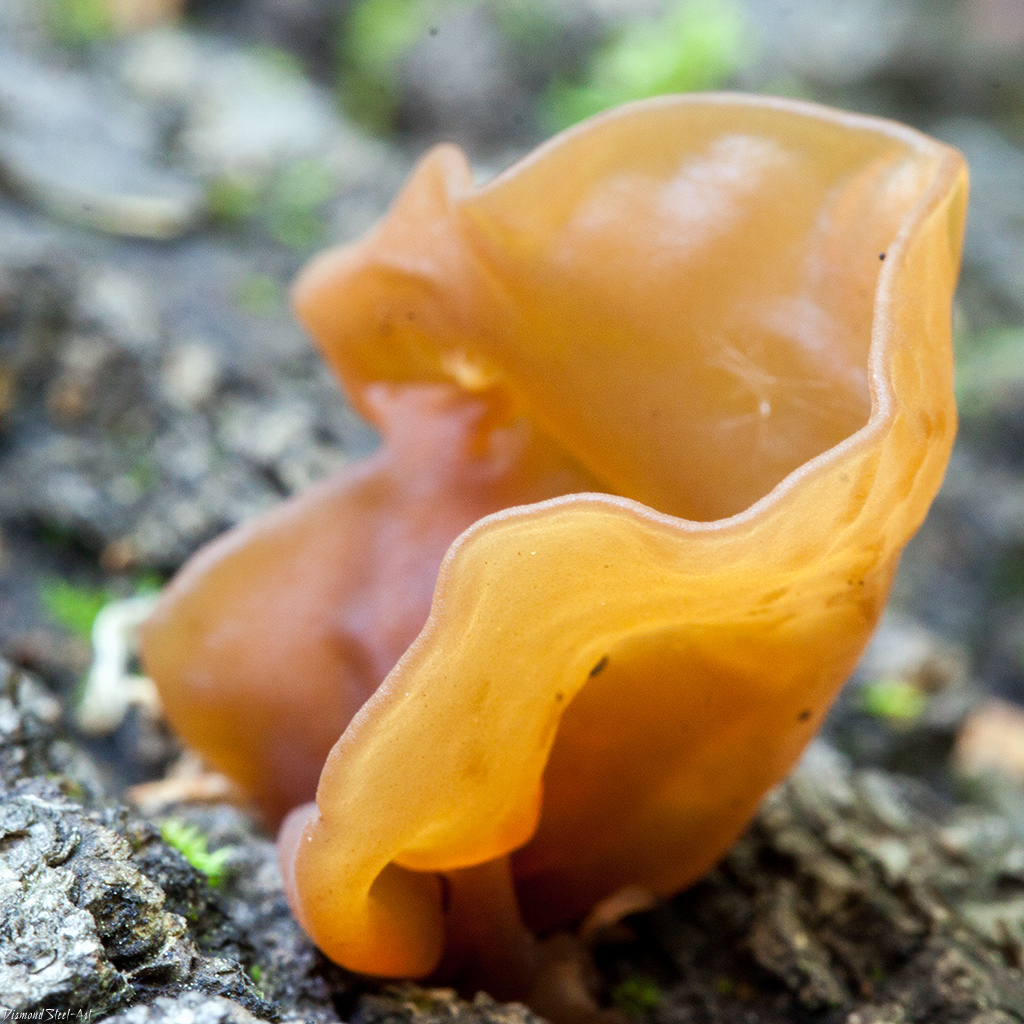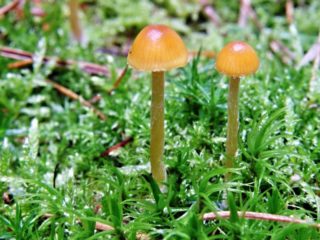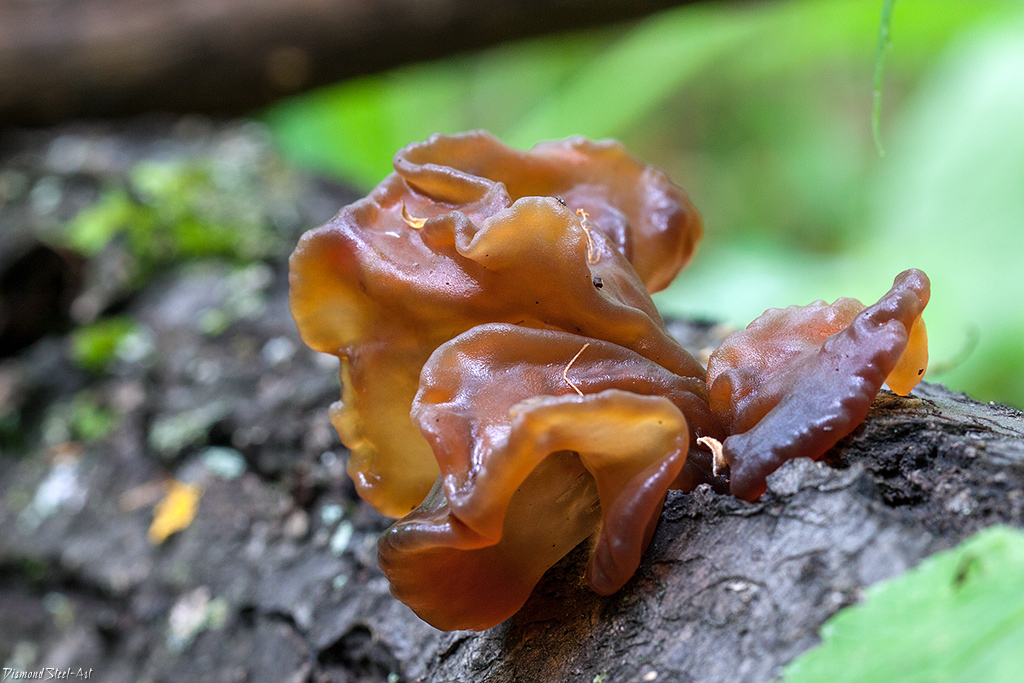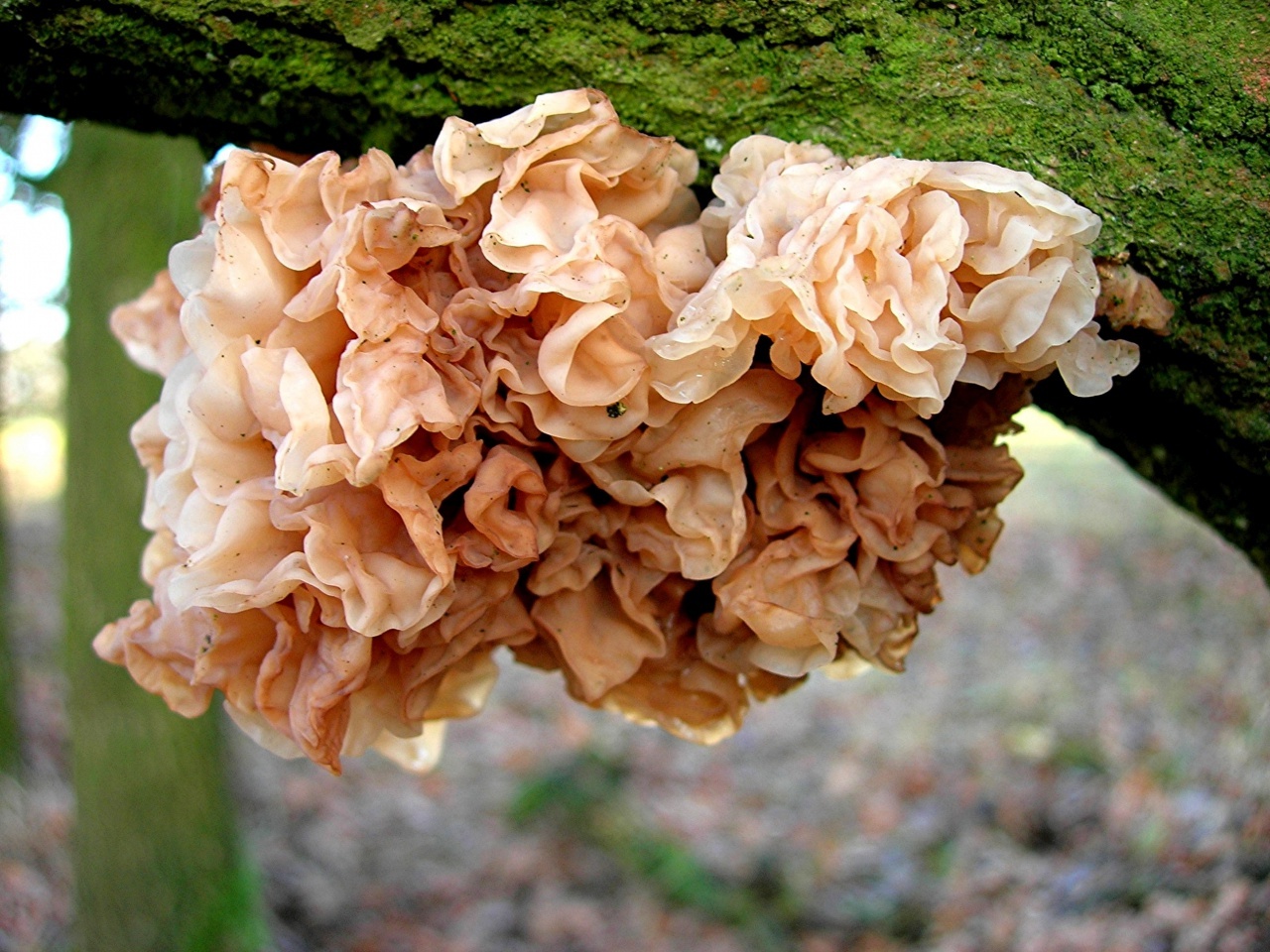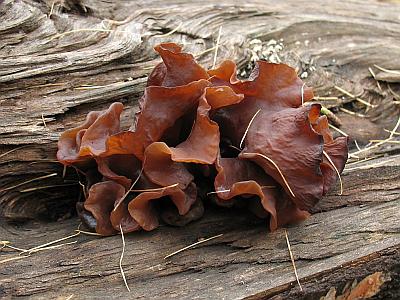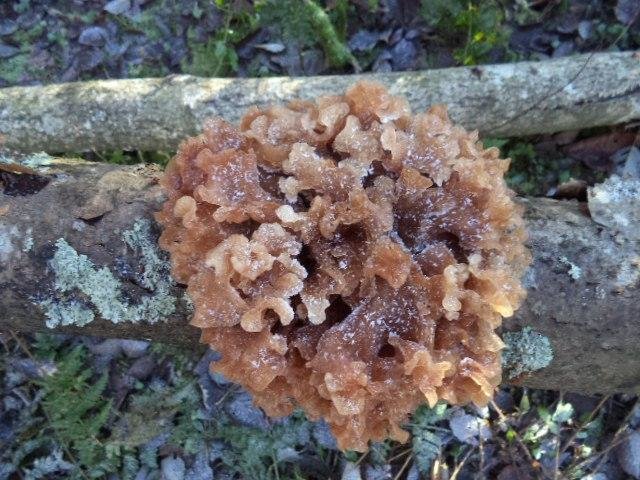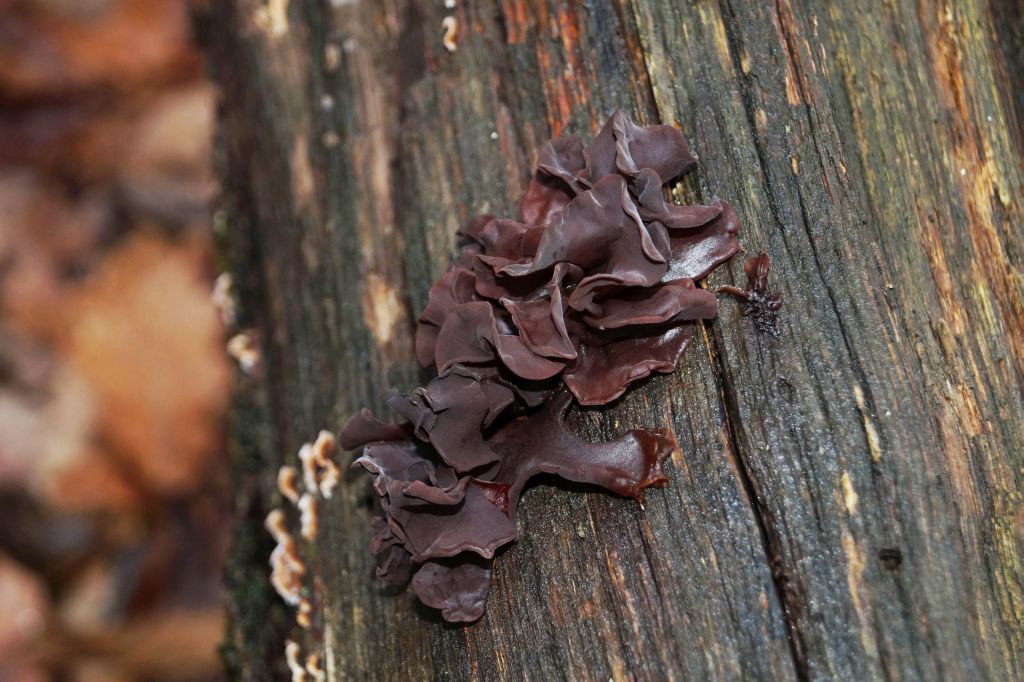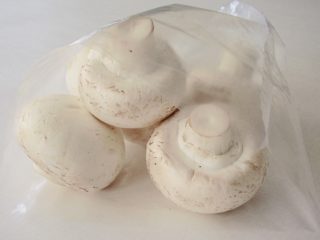Nutritional value and useful properties of chanterelles
The nutritional value is very high and the calorie content is low. The fact is that they contain vitamins such as: in A, B2, C, PP. They also contain a lot of manganese, potassium, copper and cobalt. That is why the components make the forest guest healing, universal in the fight against many pathologies. Some of them can be listed:
- night blindness;
- angina;
- obesity;
- furunculosis;
- disorders of the pancreas.
The mushrooms contain many antioxidants that help to maintain youth and stop aging of the body. Fungi protect the intestinal system from helminthic invasions. On the basis of the type of forest gifts, tinctures are created.
Leafy shiver (Phaeotremella foliacea)
Photo by K.Yu. Sinelnikov.
Synonyms: Trembling fringed Tremella foliacea Gyraria foliacea Naematelia foliacea Ulocolla foliacea Exidia foliacea
Taxonomy: Division: Basidiomycota (Basidiomycetes) Subdivision: Agaricomycotina (Agaricomycetes) Class: Tremellomycetes (Tremellomycetes) Subclass: Tremellomycetidae (Tremellomycetidae) Order: Tremellales (Pharyocephalaceae) Family: Tremeeotremella leafy)
Fruit body: 5-15 centimeters and more, the shape is varied, it can be correct, from spherical to cushion-shaped, it can be irregular, depending on the growth conditions. The body of the fungus consists of a mass of leaf-like formations that have grown together with a common base; in young specimens, until they have lost their elasticity, they give the impression of “ruffled” thin combs.
The surface is oily-moist in wet weather, in dry periods it remains wet for a long time, when dry, individual petals wrinkle in different ways, so that the shape of the fruit body is constantly changing.
Color: brownish, maroon to cinnamon brown, darker in age. When dry, they can acquire a light purple tint, later darken to almost black.
Flesh: translucent, gelatinous, firm. With the aging of the fruiting body in wet weather, the “petals” from which the mushroom is formed lose their elasticity and shape, and in dry weather they become fragile.
Odor and Taste: No particular taste or smell, sometimes described as “mild”.
The spore-bearing layer is located over the entire surface. Spores: 7-8.5 x 6-8.5 microns, subglobose to oval, smooth, non-amyloid. Spore powder: cream to pale yellowish.
The leaf tremor parasitizes other fungi of the Stereum species growing on conifers, for example, Stereum sanguinolentum (Reddening Stereum). Therefore, Phaeotremella foliacea can only be found on conifers (stumps, large valezha).
Season and distribution Widespread in Eurasia, America. The fungus can be found in different seasons of the year in varying degrees of growth or dying, since the fruiting bodies persist for a long time.
The mushroom is probably not poisonous, but its taste is so low that the question of preparation is not particularly considered.
It is a deciduous tremor that lives exclusively on deciduous species, as it parasitizes types of stereums attached to deciduous species.
Auricularia auricular (Judas ear) is distinguished by the shape of fruit chalk.
Sparassis crispa, which has a much firmer texture, is yellowish brown rather than brown, and usually grows at the base of conifers rather than directly on the wood.
Note: a bit of history
The taxonomy of the Phaeotremella foliacea group is being revised based on morphological, ecological, geographic and DNA data. The name P. foliacea is reserved for the gymnosperm species associated with Stereum sanguinolentum in Eurasia and North America. Tremella neofoliacea and Cryptococcus skinneri are considered synonymous with P. foliacea s.str. The other three species in the complex are inhabited by deciduous trees. Of these, Phaeotremella fimbriata, comb. nov. *, associated with Stereum rugosum; this species has a blackening of basidiocarps and small basidiospores, found in Europe. Its close relative is the East Asian Phaeotremella eugeniae, sp. nov., is associated with the Mongolian oak (Quercus mongolica) and has larger basidiospores. The third species, Phaeotremella frondosa, comb.nov., produces the largest basidiospores in the genus and is associated with either S. rugosum (mainly in Northern Europe) or other Stereum species (temperate Eurasia and North America). In addition, T. nigrescens is typed and synonymous with P. frondosa, and two species, T. fuscosuccinea and T. roseotincta, are combined with Phaeotremella.
* - comb. nov. (abbreviated from Lat. Combinatio nova) - a new combination, that is, a combination formed from a previously promulgated legal name
** - sp. nov. (abbreviated from Lat. Species nova) - a new species. The phrase is used after the binomial name, which is published for the first time.
Head of the plant protection laboratory of AIC "Vitus" Sinelnikov K. Yu.
Specialists of the plant protection department of AIC "Vitus" carry out entomological and phytopathological examination of green spaces, develop individual plans for plant protection measures, treat green spaces with protective agents and carry out complex plant care.
What can be confused with
Despite its bright color, orange shiver is safe for humans, so it is easily used for cooking or in treating problems. However, there are false counterparts, the use of food or preparation of which can lead to serious problems, up to poisoning and causing significant harm to the body.
Given the specific external color of the mushroom, it will be difficult to confuse it with other mushrooms. However, it should be borne in mind that there are specimens in the shivering family that very much resemble their orange counterpart.
Have you heard about this mushroom?
Yes
16.67%
No
75%
I saw him, but did not know what it was called
8.33%
Votes: 12
Let's turn to the shivering leaf. This mushroom is inedible, however, in its external structure and placement, this mushroom very much reminds us of a yellow brain.
However, a significant difference appears in color. Leaf tremor is rather dark orange or pale red. But inexperienced mushroom pickers still believe that it is a trembling orange and pluck it. Such a mushroom cannot cause poisoning, however, it has a very mediocre taste and will simply ruin a couple of dishes for you.
Another species that can be confused with the orange quiver is the fucus-shaped quiver. True, it is easy to distinguish it by its color. The fucus-shaped shiver is almost transparent, with a white undertone, as if a cloudy liquid turned into jelly and froze for a while in a strange figure.
However, some mushroom pickers are sure that this is nothing more than an albino from an orange shiver and continue to pick these mushrooms and put them in their basket. Meanwhile, the fucus-shaped shiver is also an inedible mushroom that actively absorbs negative substances and can lead to poisoning.
Collecting such mushrooms must be taken very seriously.
Fucus tremor (Tremella fuciformis)
Tremella fuciformis - an ice mushroom, which is also sometimes called snow, acquired this name due to its specific appearance - it looks like a snowy, ice ball. This species is very much appreciated in Asia - it is used both in cooking and in medicine. In fact, it is considered medicinal.
Synonyms: Nakaiomyces nipponicus, fusiform quiver, white quiver, fucus tremella, ice mushroom, snow mushroom, silver mushroom, silver ear, snow ear, jellyfish mushroom.
Tremella fucus-shaped (or trembling white) belongs to the Tremellaceae family, of the genus Tremella.
This mushroom also has other names, and all because of the fact that in different countries and continents it is called in different ways, namely: edible gelatinous mushroom, silver ear, coral mushroom, snow mushroom, fucus shiver, sea cep, silver mushroom, silver ears.
Appearance
The fruit body is unusual, sinuous, as if it were in a fold, irregular in shape, reminiscent of algae collected in a bunch. The size can be from 2 to 10 cm.
The color is snow-white; specimens with a yellowish tint are less common.
The flesh of the trembling white is tender, translucent, fleshy, elastic-gelatinous, white, almost odorless, or less often - with a weak spicy smell.
Where does the ice mushroom grow
It can be found in deciduous and mixed forests. It grows on decaying, decayed wood and fallen trunks, as well as on the branches of deciduous trees (the favorite type of tree is oak). Occurs both singly and in groups.
Similarities with other species
White ice mushrooms are very difficult to confuse with other species - they look very unique. The only kind with which it can be confused is with a shivering orange, and then, only if, for some reason, it completely loses its colorful color. But this is not scary, since the orange shiver is also an edible mushroom.
Fucus trimella is an edible species. Most often it is used for preparing Asian dishes. And although by itself it does not have any pronounced taste, nevertheless, it crunches extremely appetizingly, thanks to its elastic texture.
Salads and soups are most often prepared from the white shiver. In our area, most often the mushroom can be found in various Korean snacks, for example, seaweed with coral mushrooms. But sometimes even sweet desserts are made from it - ice cream, drinks, syrups.
The trembling mushroom is quite nutritious - it contains proteins, useful minerals and trace elements, fiber. And also as many as 18 amino acids! It is believed that these mushrooms contain more vitamin D than, for example, cod liver and tuna combined.
Fucus tremella does not need long-term heat treatment - usually 5 minutes of boiling is enough to cook it, and at the same time the fruit body increases significantly in size.
Most often, the shiver can be found on sale in a dried form, and not fresh. In order for dried mushrooms to be used as food, they need to be poured with lukewarm water and left to soak in moisture for a couple of hours (even longer). Then put it on a sieve, and wait for all the liquid to glass. Well, then cook either salads and snacks, or soups. By the way, mushrooms saturated with moisture do not differ at all from fresh ones.
Ice mushroom: benefits and medicinal properties
Tremella also contains a substance that can prevent leukopenia (a drop in the number of leukocytes) in people undergoing chemotherapy and radiotherapy, and quickly restore bone marrow health. In addition, shiver white extract kills cancer cells in the cervix and certain types of other tumors.
In addition to being used in medicine, the coral mushroom is also used in cosmetology. Thanks to its high content of vitamin D, it is able to rejuvenate the skin and even smooth out wrinkles! But, despite the usefulness of this mushroom, you need to be careful with it during pregnancy and lactation, and it is better to completely abandon it. It should not be given to children and should not be consumed if you are prescribed anticoagulants.
Tremella foliacea
The description of the view on this page is out of date or needs some work. We'll be back here soon and we will finish everything.
Current title
| Index Fungorum | Tremella foliacea Pers. |
| MycoBank | Phaeotremella pseudofoliacea Rea |
Systematic position
Fungi, Basidiomycota, Tremellomycetes, Tremellales, Tremellaceae, Tremella
Etymology of the species epithet
Foliāceus, a, um, from leaf, referring to leaf.
Synonyms
- Gyraria foliacea (Pers.) Gray, Nat. Arr. Brit. Pl. (London) 1: 594 (1821)
- Naematelia foliacea (Pers.) Bonord., (1864)
- Ulocolla foliacea (Pers.) Bref., Unters. Gesammtgeb. Mykol. (Liepzig) 7:98 (1888)
- Exidia foliacea (Pers.) P. Karst., Bidr. Känn. Finl. Nat. Folk 48: 449 (1889)
- Tremella fimbriata Pers., Observ. mycol. (Lipsiae) 2: 97 (1800)
- Tremella ferruginea Sm. In Smith & Sowerby, Engl. Fl. (London): tab. 1454 (1805)
- Gyraria ferruginea (Sm.) Gray, Nat. Arr. Brit. Pl. (London) 1: 593 (1821)
- Tremella succinea Pers., Mycol. eur. (Erlanga) 1: 101 (1822)
- Tremella nigrescens Fr., Summa veg. Scand., Sectio Post. (Stockholm): 341 (1849)
- Phaeotremella pseudofoliacea Rea, Trans. Br. mycol. Soc. 3 (5): 377 (1912)
Habit
Fruit body: Gelatinous, gelatinous
Hymenophore: Smooth, not pronounced
Fruiting body
Fruiting bodies of fungi are lobed, leaf-shaped, gelatinous and gelatinous (in the brain-like group), with a blunt edge, rusty-brown to reddish-brown, lighter in youth, darken with age, brown or blackish when dry, horny, shriveled and harden.Collected in groups up to 10 - 20 cm wide and 5 cm high.
Microscopy
Spores are smooth, rounded to oval, 7 - 8.5 × 6 - 8 µm.
Ecology and distribution
Substance: Woody plants (living trees, bark and dead wood)
It grows on dead wood and weakened deciduous trees (mainly oak and birch) and conifers.
It is rare in the Novosibirsk region. Regularly bears fruit on oak fallen trees in artificial plantations on the territory of the Central Siberian Garden of the SB RAS; recorded singly on birch fallen trees at the border of a forest and a swamp in the Shlyuzovsky bog complex. Mention is made of the discovery of an aspen tree in the Toguchinsky region in 1984
Fruiting
June - September.
JanFebMarAprMayJun
JulAugSenOctNoveDec
The divisions correspond to the decades of the month.
Nutritional properties
Unknown
Orange shiver
Family: Tremellaceae.
Synonyms: membranous tremor, mesenteric tremor.
Description. Like the fucus-shaped shiver, this fungus parasitizes on the mycelium of the host fungus (tinder fungus of the genus Peniophora) located in the rotting wood. The fruit body is pale yellow, yellow, sometimes to orange, partly transparent, 1-10 cm, at a young age, cerebral, later folded, gelatinous, dense gelatinous, often with a sticky surface. In dry weather, the fruiting bodies dry out, taking the form of crusts adhering to the substrate. When the humidity changes, the crusts swell and the mushroom regains its normal shape. With excessive moisture, it fades to white, translucent. Old fruiting bodies dry up, darken, become flattened and coarser.
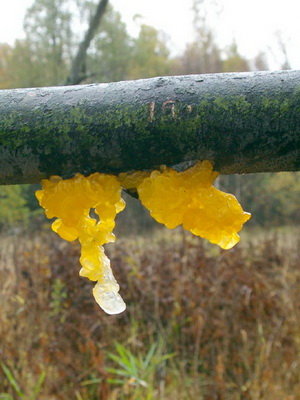

The orange shiver mushroom grows throughout the forest zone of Russia, often, in places abundantly. Following the host fungus, it settles on the trunks, branches and stumps of deciduous, much less often - conifers. Sometimes there is a simultaneous fruiting of the tremor and the peniophora affected by it. The orange tremor bears fruit from August to May (freezes in winter and continues to develop with the onset of a thaw).
Similar species. Fruit bodies, discolored to white in rainy weather, can be confused with trembling fucus, but only in the Primorsky Territory.
Medicinal properties: The biologically active polysaccharide glucuronoxylomannan was isolated from the orange shiver. Laboratory tests have shown that it has immunostimulating, radioprotective, antidiabetic, anti-inflammatory and anti-allergenic activity, and also participates in the protection of the liver (hepatitis B).
Ethanol extract of fresh fruiting bodies causes complete death of A549 cancer cells (lung cancer), increases the production of interferon and interleukin-2, kills cervical cancer cells and enhances the effect of chemotherapy.
In China, on the basis of glucuronoxylomannan, several medications are patented (antineoplastic, anti-inflammatory, blood pressure regulating).
The fruit bodies of the tremors contain essential amino acids and B vitamins, which makes these mushrooms valuable not only in medicinal but also nutritionally.
For medicinal products, the mushroom is cultivated by the deep method (China).
Application in traditional medicine: In Chinese traditional medicine, orange tremor was used as a general tonic, for the treatment of pulmonary diseases, bronchitis, as well as for paralysis, inflammation of the eyes and as a sedative.
It is known to be used in England (rubbing with a fresh fruiting body) for the healing of skin ulcers.
Here is one of the Bulgarian folk recipes as an example:
Take 3-6 g of dried mushrooms or 30-60 g fresh, add water and cook over low heat until pasty, adding a little honey at the end of cooking. Drink before bed for 10 days. Helps with colds, flu, bronchitis, asthma and general weakness.
Cooking application: Orange shiver mushroom is edible, used fresh for salads (with the addition of sweet and sour dressing). From fresh or dried fruit bodies, nutritious broths are cooked.
In China, it is considered a delicacy; among other recipes, it is used to prepare immunomodulatory cold vegetarian soups (with the addition of lotus seeds, lily bulbs, Chinese dates, etc.).
Interesting Facts. One of the English names for the orange shiver is translated as "star jelly". It dates back to the Middle Ages, when it was believed that the fruiting bodies were trembling - the remnants of the light of fallen meteorites. This is exactly what is said in the 15th century encyclopedia of the English pioneer printer William Caxton.
Preparation
The shiver can be eaten. It is eaten fresh or added to various salads as a decoration. You can also make a very healthy broth from these mushrooms.
In China, shivers are considered delicacies and are highly prized. The Chinese prepare soups for vegetarians and add various ingredients to the dishes.
Cleaning
After you have collected the tremella, it must be properly processed:
- Rinse under running water.
- Pry the skin with a knife and remove.
- Rinse thoroughly again.
Cooking
The main thing you need to know is that the orange tremor needs additional preparation before use. The mushrooms must be boiled, and the duration of the process depends on the method of preparation. On average, it will take you about half an hour.
Pickling
This mushroom is useful in any form, and pickled tremella is also very tasty. They can be eaten as a standalone snack or served with a side dish.
To do this, you will need:
- mushrooms - 2 kg;
- seasoning for Korean carrots - 20-30 grams;
- salt - 1 tbsp. l .;
- sugar - 0.5 tbsp. l .;
- garlic -2 cloves;
- black and white pepper - 1 tsp each.
Step by step cooking
- Take the required amount of dried or fresh mushrooms and soak in water. If they are completely dry, then for 2 hours.
- Add seasoning, salt, sugar, garlic, pepper.
- All ingredients must be thoroughly mixed so that the spices are evenly distributed.
- After that, the resulting mixture is laid out in glass jars and tightly screwed with lids.
Freezing
The washed mushrooms must be prepared for freezing:
- Clean them from damaged parts.
- Soak for ten minutes in water and then discard in a colander.
- After the water is drained, put the shakes on a dry towel - let the excess moisture go away.
- Then place them in plastic containers or bags and put them in the freezer.
Frying
What needs to be done:
Take dry mushrooms and place them in water for half an hour.
After this time, drain the water and discard in a colander
Please note - they should double in size.
Cut into random pieces.
After that, put the mushrooms in a preheated pan with vegetable oil and lightly fry. You can add soy sauce to taste.
Serve any salad, porridge or potatoes as a side dish.
Salting
For salting you will need:
- Boil the fungi for about 15 minutes in salted water (half a tablespoon per liter of water).
- Organize into banks.
- Pour with seasoned brine, you can add citric acid.
- Roll the jars and put them in a warm place with a blanket.
- After they have completely cooled down, you need to put them in a cool place.
Drying
Well washed and peeled mushrooms must be dried. To do this, use an oven or special drying cabinets. Here's what to do:
- Peel the mushrooms, wipe with a napkin.
- Cut large specimens into pieces.
- Place on a wire rack and place in the oven for about 3 hours (temperature - 60 degrees).
Ingredients:
- 1 kg of mushrooms;
- 200 ml of vodka or alcohol.
Step by step cooking
- Place the peeled tremella in a jar.
- Top up with vodka or alcohol.
- Place in a dark, dry place for 20-25 days.
The tincture can be used for external use as it has an anti-inflammatory effect.
Soup recipe
Ingredients:
- 100 grams of dried shiver;
- 1 handful of lotus seeds;
- 1 Chinese pear (can be replaced with a regular one);
- 10 pieces. red dates;
- a handful of goji berries.
Step by step cooking
- Take dried mushrooms and place them in water for twenty minutes.
- Then fold in a colander.
- Go through and remove all damaged areas, chop into small pieces.
- Place in a saucepan and cover with clean water.
- Put it on gas. Add lotus seeds, chopped pear, dates.
- Add goji berries at the end. Season with sugar to taste, if necessary.
The total cooking time for this soup is approximately one hour. An indicator of readiness will be a fourfold increase in the mushroom. In addition, it must lose its color. According to Chinese doctors, eating soup will give you strength and energy, and increase immunity.
Cosmetic and medicinal properties of the Snow Mushroom
For a long time, Chinese aristocrats have used Silver Ear for skin care, finding that its components lighten the skin and eliminate oily sheen, freckles and various age spots. These properties have been confirmed by modern scientists.

The healing properties of the Snow Mushroom
Creams with Shivering White moisturize and smooth the skin, prevent rosacea, eliminate fine wrinkles. Sunscreens with the addition of mushroom contribute to a better tan without scalding and overdrying the skin.
On the Far East and Ussuri land, Drozhalka fucus is considered a longevity mushroom and is used to increase endurance, strengthen overall tone and increase life expectancy.
Deciduous
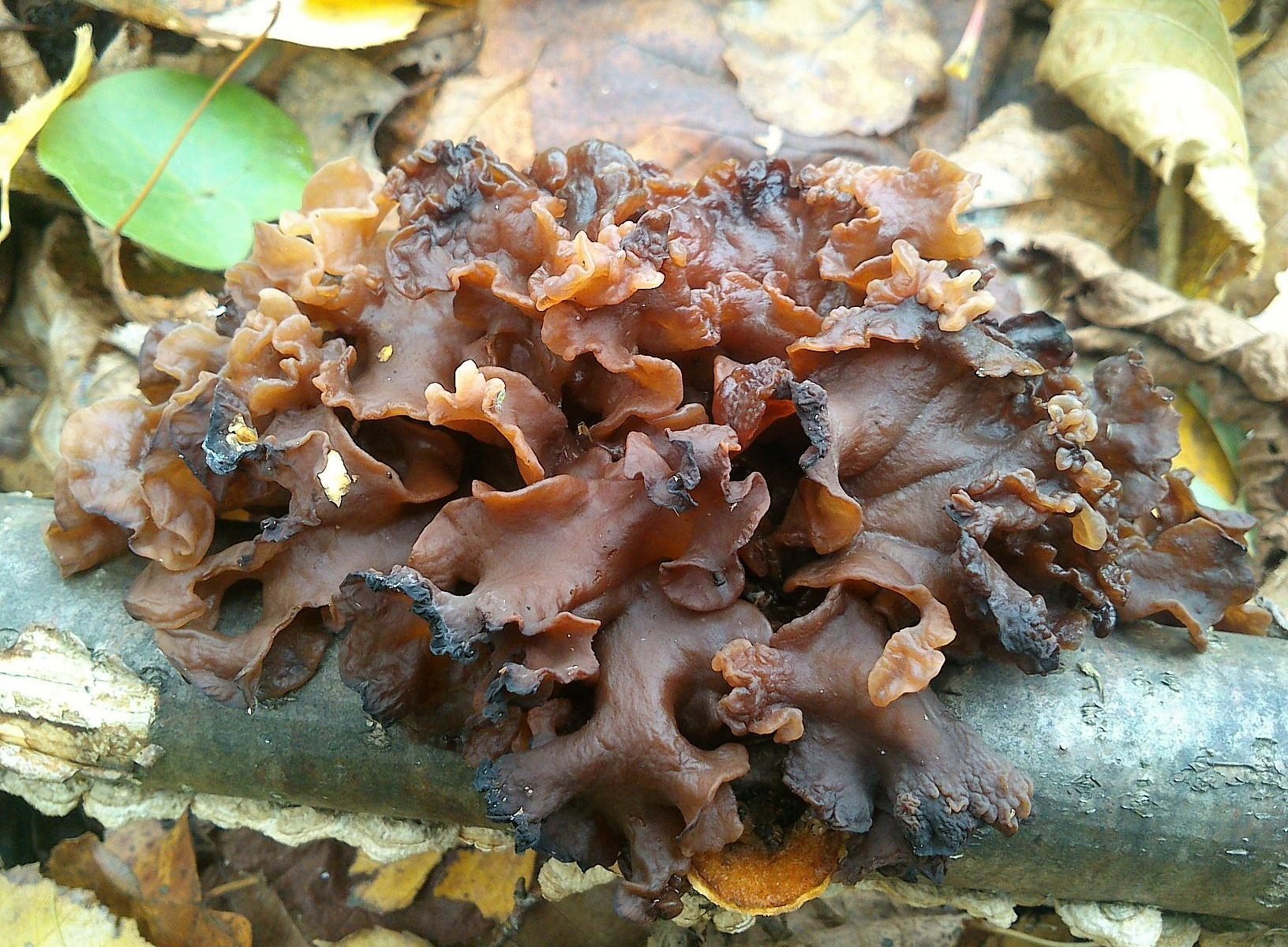
Tremella frondosa
Parasitizing various types of Stereums growing on deciduous wood, this well-known jelly-like fungus is quite easy to identify by its brown color and well-developed individual lobules, which strongly resemble "petals", "leaves".
Description
The fruit body is a mass of densely packed slices. Overall dimensions are approximately 4 to 20 centimeters across and 2–7 centimeters high, in various shapes. Individual lobes: 2–5 cm across and 1–2 mm thick. The outer edge is even, each lobule becomes wrinkled to the place of attachment. The surface is bare, damp, oily wet in wet weather and sticky in dry weather.
Color from light brownish to brown, dark brown. Older specimens may darken to almost black.
The pulp is gelatinous, translucent, brown.
The leg is missing.
Smell and taste: no particular smell or taste.
Chemical reactions: KOH - negative on the surface. Iron salts - negatively on the surface.
Microscopic features Spores: 5–8.5 x 4–6 µm, ellipsoidal with prominent apiculus, smooth, smooth, hyaline in KOH. Basidia up to about 20 x 15 µm, ellipsoid to rounded, almost spherical. There is a longitudinal septum and 4 long, finger-like sterigmas. Hyphae 2.5–5 µm wide; often gelatinized, cloisonné, pinched.
Ecology
It parasitizes various types of Stereum, for example, Stereum rugosum, Stereum ostrea and Stereum complicatum. Grows on dry deciduous trees.
Season and distribution
Deciduous trees can be found in spring, autumn or even winter in warm climates. The mushroom is widespread in Europe, Asia, North America. It is common.
Types and varieties of pontederia
Pontederia cordata (Pontederia cordata) is a European-American shallow and marsh perennial up to 60 cm high.The plant develops at the beginning in the form of a very beautiful and round bush, gradually forms compact, but increasingly dense thickets, which seem to be an architectural design element. Numerous leaves up to 25 cm long and 18 cm wide rise above the water on long, powerful cuttings. The plates seem hard and dense, but they shine through in the sun, making the pontederia look even more interesting. The color of the leaves is not marsh, but rich green, and the surface is always perfectly glossy. The heart-shaped base and pointed edge of the lanceolate or ovoid leaf blade look austere and almost flawless detail.
Even very young pontederia produce numerous peduncles, on which, in addition to the crowning inflorescence, is located and very similar to a basal leaf. The spike of inflorescences is massive, dense, with two-lipped blue or purple flowers with a light, lilac-shining color tightly sitting in it. The shape of the inflorescence resembles a cob of reeds, but its lace pattern gives it a visual lightness. Despite the fact that it is difficult to distinguish between individual flowers, you should take a closer look at the pontederia. The lower lip of the flowers is three-lobed, the upper lip is solid, but it is decorated with a pair of bright yellow spots. But the most unusual feature of pontederia is the color of the pistil and stamens. In this culture, they are blue. The flowering of the heart-leaved pontederia starts at the very beginning of summer, only in extremely unfavorable seasons it is delayed until July. But flowering ends, as befits a late plant, when the breath of winter is already felt in the garden - in the second half of October.
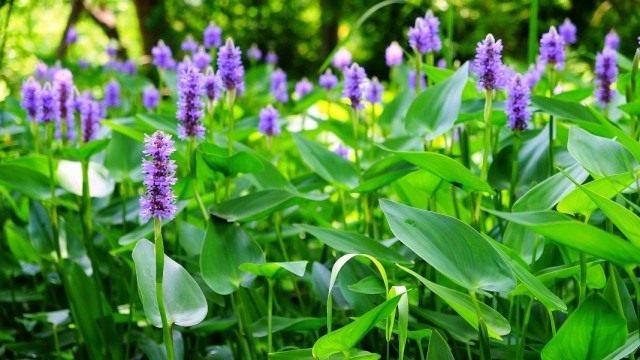
In addition to the basic form, there are decorative varieties and varieties of pontederia. We have only a few cultivars that have become classic:
- Heart-leaved Pontederia "Pink Pons" with pink inflorescences;
- Heart-leaved pontederia "Dilatata" with lilac-pink, very long inflorescences;
- Pontederia cordial "Gray Thunder" with seeming gray, but actually blue inflorescences and huge leaves, from 30 cm in length;
- Pontederia hearty "Alba" with snow-white flowers;
- Pontederia hearty "Spoon River" with blue inflorescences and oval, spoon-like leaves (this is the only non-glossy variety of pontederia).
Some modern varieties have higher frost resistance, for example, the bright blue variety "Crown Point", which is assigned to zone 4a.
Doubles and their differences
- The deciduous tremor differs in that it lives only on deciduous trees. The edibility of this representative of the mushroom family is unknown, there is no data on the toxicity. It is known not to be used for food, because does not taste good. It belongs to conditionally edible, but it is not used for cooking.
- Curly Sparassis is an edible representative of the Sparassaceae mushroom family. Refers to parasites. The pulp is white, firm. It tastes like a nut.
- Auricularia auricular is an edible representative of the Auriculyariev family. It is a parasite, grows on deciduous trees, on dead, weakened specimens, felled trunks, stumps. Auricularia auricular got its name from its specific shape, reminiscent of the human auricle.
- Orange tremor (Tremella mesenterica) is a conditionally edible representative of the mushroom kingdom. It is prized for its medicinal properties. The pulp has no specific taste or smell. Glucuronoxylomannan is a polysaccharide compound that is obtained from the orange shiver. It is used to relieve inflammatory processes. It is also used to treat allergic diseases. The substance has a positive effect on the immune system, the excretory system. Helps the liver and the entire hepatobiliary system. It is used in traditional medicine.
Leafy shiver - description of where it grows, the toxicity of the mushroom
Any mushroom picker has met a shivering leaf in his life. It is difficult to pass by it, as it attracts with its unusual shape and color. The mushroom is vaguely similar to a red beard, which hangs down in damp weather, and, on the contrary, shrinks in dry weather. This type is used to treat many diseases: skin diseases, bronchitis and even cancer. Let's consider it in detail, as well as other varieties of the family, their features.
Appearance
This mushroom body has a translucent, orange color, consisting of smooth blades attached to each other. The older it is, the more it looks like a human brain. The mushroom does not grow too large, its height is 4 cm. When it touches the fruiting body, it trembles, resembling frozen jelly. The surface is sticky.
Despite the fact that the mushroom resembles a jelly, it has a strong structure. The main feature is the change in color and consistency. In dry hot weather, when there is no precipitation, the pulp dries up and takes on a darker shade.With increasing humidity, the shiver returns to its original state. The fungus has many pores all over the body, so it appears white. The fruiting body has no smell, absolutely like a taste.
Where is it found?
Leafy shiver grows in almost any terrain: mountains, plains and forests. The fruiting body favors rotten trees, stumps and dried leaves. Considering the unusual appearance of the leafy shiver, it is difficult to confuse it with other types of mushrooms. Sometimes it is possible not to recognize it, since the Drozhalkov family has many subspecies. The only sign by which you can distinguish them is color, since they have the same shape.
Medicinal properties of orange shiver
A representative of the Drozhalkov family has in its structure a special substance that helps to fight allergies, diabetes, stop many inflammatory processes, and is also an immunomodulator. In addition, it contains amino acids and vitamin B. As a rule, alcohol tincture is prepared from the mushroom and used to relieve tumors.
Ethanol elixir is made from fresh orange shivers. It is prescribed when undergoing chemotherapy. Together with it, it blocks the development of cancer cells, and in some cases completely kills. Chinese doctors have patented several medicines based on this mushroom. Soon they will be available to the population. In Asian countries, these mushrooms are beneficial and fight against their destruction. They are used to treat many diseases: bronchitis; paralysis, etc. The British use orange tremors to treat skin conditions.
Other types of mushrooms
This family is also represented by other types:
- Fucus-shaped trembling. This mushroom is eaten. Color - white, shape - blades. This species is found in China, Japan and Korea.
- Brain trembling. This mushroom is not edible. It resembles a human brain in shape. Color - white or yellow. Mushrooms prefer to grow on conifers.
Similarities with other species
The leaf tremor is similar in its characteristics to auricular auricular. For growth, she chooses a black elderberry. This is a conditionally edible mushroom and even healthy. It is used to make broths. This type is especially appreciated in Asian countries, where it is used for making cold soups. The population claims that the exotic mushroom enhances immunity. However, there is one peculiarity - it is almost impossible to bring auricularia from the forest, as it evaporates.
Shivering leaf or fringed is a prominent representative of the family. It is quite easy to find in the forest for its bright color and unusual shape. It has the consistency of jelly, which dries up in dry weather, and vice versa in wet weather. You cannot eat a mushroom, unlike similar species.

